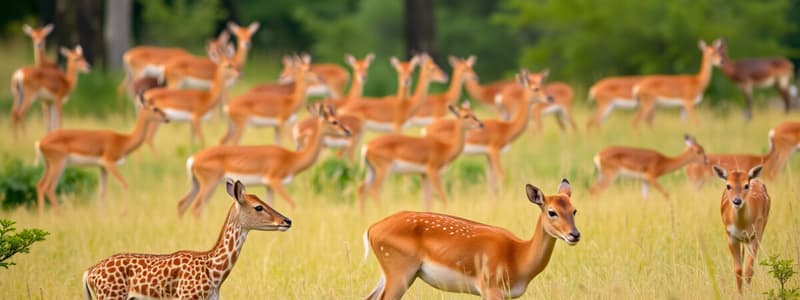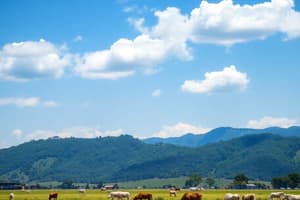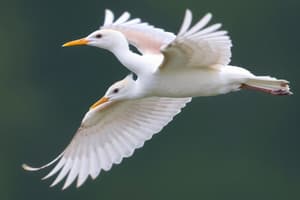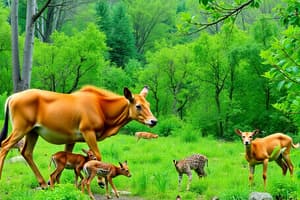Podcast
Questions and Answers
Which of the following does not represent a population?
Which of the following does not represent a population?
- All the robins in Austin, Texas
- All the grass frogs in the pond of Central Park, New York City
- All the squirrels in North America
- All the birds in Chicago, Illinois (correct)
What is the likely outcome as individuals in a population tend to produce more than one offspring?
What is the likely outcome as individuals in a population tend to produce more than one offspring?
- The population tends to decrease rapidly.
- The population remains stable in size.
- The individuals die quickly.
- The population tends to increase in size. (correct)
As a population reaches its carrying capacity, which of the following will likely increase within the population?
As a population reaches its carrying capacity, which of the following will likely increase within the population?
- Available shelter
- Birthrate
- Competition (correct)
- Available food
Which of the following is not considered an abiotic factor affecting population size?
Which of the following is not considered an abiotic factor affecting population size?
What is a biotic factor that affects population size?
What is a biotic factor that affects population size?
What relationship does plentiful resources share with growth rate?
What relationship does plentiful resources share with growth rate?
As the density of a population increases, what kind of factors often lead to increased effects of starvation and disease?
As the density of a population increases, what kind of factors often lead to increased effects of starvation and disease?
What contributed to the exponential growth of the human population during the middle of the 1700s?
What contributed to the exponential growth of the human population during the middle of the 1700s?
How have better sanitation, hygiene, and disease control affected the human population?
How have better sanitation, hygiene, and disease control affected the human population?
What has been a key effect of vaccines on human population growth?
What has been a key effect of vaccines on human population growth?
Which of the following is not an example of a predator-prey relationship?
Which of the following is not an example of a predator-prey relationship?
What defines the size of a population?
What defines the size of a population?
Which dispersion pattern is the most common among populations?
Which dispersion pattern is the most common among populations?
What is a key characteristic of exponential growth in populations?
What is a key characteristic of exponential growth in populations?
Which of the following variables does not limit the size of a population?
Which of the following variables does not limit the size of a population?
What is the primary feature of logistic growth in populations?
What is the primary feature of logistic growth in populations?
In what scenario would random spacing of individuals typically occur?
In what scenario would random spacing of individuals typically occur?
Which of the following best describes a producer-consumer relationship?
Which of the following best describes a producer-consumer relationship?
What is not true about population density?
What is not true about population density?
Most animals can be described as which of the following?
Most animals can be described as which of the following?
Flashcards
Population definition
Population definition
A group of organisms of the same species living in the same area at the same time.
Population growth
Population growth
Increase in the number of individuals in a population over time, usually due to more birth than death.
Carrying capacity
Carrying capacity
The maximum population size of a species that the environment can sustain indefinitely.
Abiotic factor
Abiotic factor
Signup and view all the flashcards
Biotic factor
Biotic factor
Signup and view all the flashcards
Density-dependent factors
Density-dependent factors
Signup and view all the flashcards
Human population growth
Human population growth
Signup and view all the flashcards
Death rate
Death rate
Signup and view all the flashcards
Parasitism
Parasitism
Signup and view all the flashcards
Herbivory
Herbivory
Signup and view all the flashcards
Predator-Prey Relationship
Predator-Prey Relationship
Signup and view all the flashcards
Predator-Prey Example (Incorrect)
Predator-Prey Example (Incorrect)
Signup and view all the flashcards
Population Size
Population Size
Signup and view all the flashcards
Population Density
Population Density
Signup and view all the flashcards
Population Dispersion
Population Dispersion
Signup and view all the flashcards
Clumped Dispersion
Clumped Dispersion
Signup and view all the flashcards
Uniform Dispersion
Uniform Dispersion
Signup and view all the flashcards
Random Dispersion
Random Dispersion
Signup and view all the flashcards
Exponential Growth
Exponential Growth
Signup and view all the flashcards
Logistic Growth
Logistic Growth
Signup and view all the flashcards
Study Notes
Population Characteristics and Growth
- Population: A group of individuals of the same species living in the same area.
- Population size: Total number of individuals in a population, affected by births, deaths, immigration, and emigration.
- Population density: Number of individuals per unit area or volume; estimated using sampling techniques.
- Population dispersion: Spatial arrangement of individuals within a population's area; patterns include clumped (most common), uniform, and random.
Population Growth Types
- Exponential growth: Continuous, theoretical growth; occurs when resources are abundant.
- Logistic growth (limited growth): Actual growth; affected by limiting factors (e.g., resources, space, disease); population approaches a carrying capacity.
Factors Affecting Population Size
- Abiotic factors: Non-living factors like weather, climate, water availability, and human impact.
- Biotic factors: Living factors that influence population size, such as food availability.
- Density-dependent factors: Factors whose impact increases with population density (e.g., disease, competition).
- Density-independent factors: Factors that affect the population regardless of density (e.g., natural disasters).
Interrelationships within Populations
- Competition: Occurs when resources are limited; increases with population density.
- Predation/Prey relationships: One organism (predator) hunts and kills another (prey) for food.
- Parasitism: One organism (parasite) benefits at the expense of another (host).
- Herbivory: Herbivores feeding on plants; plants don't usually die, but may be affected.
- Symbiosis/mutualism: A close relationship between two species where both benefit.
Human Population Growth
- Human population growth increased exponentially during the Industrial Revolution.
- Improved sanitation, hygiene, and disease control lowered death rates.
- Vaccines reduced death rates, contributing to population growth.
- The current global human population is substantially above 6 billion.
Studying That Suits You
Use AI to generate personalized quizzes and flashcards to suit your learning preferences.
Description
Explore the key concepts of population characteristics and growth types in this quiz. Learn about population size, density, dispersion, and the factors influencing these dynamics. Additionally, discover the differences between exponential and logistic growth.




